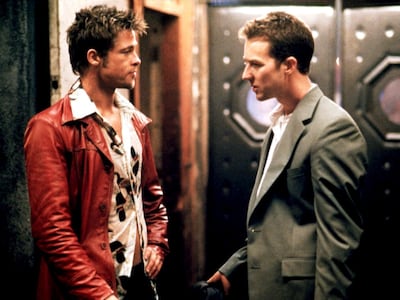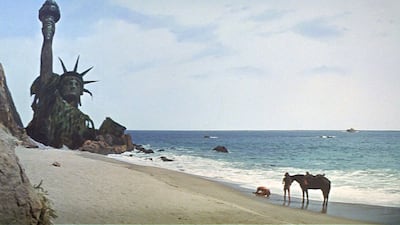Why do we love twists in films? Is it the surprise of not seeing it coming? Or perhaps it’s the thrill of watching filmmakers try to pull it off? Either way, it has become a strong tool to help make a film more intriguing, and thus, more enjoyable.
Writing a twist into a film doesn't always pay dividends, however. The wrong third-act turn can feel forced and unearned, exposing an entire story's weaknesses in the process.
But when done well, the storytelling trope reframes everything that came before it, compelling us to go back and watch it again with new eyes. One of the pre-eminent twist executioners is M Night Shyamalan, whose films are often judged on the strength of their big reveals.
With his latest twist-fest Trap now in cinemas and on the anniversary of his breakout film's release, The National looks at some of the most memorable twists in film history and breaks down what made them so good.
Fair warning, every twist in these films will be spoilt, so watch them before venturing forth.
1. The Sixth Sense (1999)

Ask any regular member of the cinema-going public what their favourite twist is and it's likely to be Shyamalan's The Sixth Sense. The film, starring Bruce Willis and Haley Joel Osment, has become the archetype of horror-tinged drama, the first of many explorations of grief told in the guise of a spooky tale.
The twist is this: throughout the film, we follow Willis, who plays a child psychiatrist called Malcolm, and his young patient Cole, played by Osment. The latter can see the dead. They come to him crying out for help, unaware they are dead.
As the film moves along, we’re led to believe that Malcolm is there to help Cole overcome his fears as a professional assignment. Meanwhile, his wife ignores him because their marriage has fallen apart. But it's revealed that Willis himself is a ghost, too, killed by one of his former patients.
2. Psycho (1960)
Horror master Sir Alfred Hitchcock delivered not one but two twists in his seminal 1960 film Psycho. The film, starring Anthony Perkins, Janet Leigh and Vera Miles, tells the story of a woman on the run who takes refuge at a motel.
Psycho’s first twist comes early on, when someone appearing to be the mother of the motel owner Norman Bates kills the lead of the film in a gruesome shower sequence that has become the gold standard of death scenes. To dispense a star of Leigh's status halfway through the film was certainly a surprise.
The second twist, and the one that really sticks in people’s minds after watching the film, is that Bates is the murderer himself, dressing up as his dead mother who exists as an alternate personality in his fractured mind.
Both have been imitated in many films since, a homage that's become something of a cliche.
3. Fight Club (1999)

Director David Fincher has become known for his cunning and smartly executed plot twists. In The Game, the big shock is expected but still feels surprising when it is revealed the events of the film were just, as the title suggests, a game.
His film Gone Girl (2014) also has a great twist when it is revealed that Rosamund Pike’s character Amy wasn’t kidnapped at all but was setting it up to frame her estranged husband. But it’s 1999’s Fight Club that stands as the Fincher film with the most impactful twist to date.
Adapted from the Chuck Palahniuk book of the same name, the film deals with themes of masculinity, disillusion with modern society and the yearning to break free from the shackles imposed on us by ourselves.
The film stars Brad Pitt and Edward Norton as Tyler Durden and The Narrator who we’re led to believe are two different people, until in the end when it’s revealed Norton’s character has been imagining Pitt’s the whole time.
The beauty of this twist is how many signs along the way were planted to hint at it, making the film a must for repeat viewings.
4. The Others (2001)
Ghost stories are a fixture of horror. Seeing characters navigate an empty house while hearing noises and creaks they can’t explain will still deliver goosebumps no matter how much we get used to the subgenre.
In Alejandro Amenabar’s 2001 horror film The Others, we follow a mother and her two children who we’re told are photosensitive to the light and need to be kept in darkness. The trio, alongside help staff, become increasingly convinced their house is haunted.
What could the twist be then in what at first seems like a straightforward ghost story? The characters we’ve been following the whole film are themselves the ghosts. It isn’t a complete surprise, and it does make complete sense when it’s revealed, but the way in which the twist is revealed turns the film’s genre from horror to tragedy in one single scene.
5. Frozen (2013)

Children’s films aren’t exempt from the trope. Recent animated films like Wreck-It Ralph and Coco have great twists that elevate them from normal fare to exciting and emotional adventures.
The most memorable modern animated children’s film with a twist remains Frozen. It became a box office smash in 2013, driven by the popularity of the song Let It Go. Frozen’s twist is not only brilliant because of how unexpected it is, but also because it plays on the sort of expectations viewers have set from the years of Disney and Pixar films.
The prince charming storyline has found its way into just about every princess fairytale, becoming a fixture of Disney’s films for decades. When a handsome hero is introduced in these stories, the expectation is that they will fall in love with the princess, giving him a reason to protect her or fight for her.
Frozen on the other hand makes its prince charming, Hans, the villain. But that isn’t revealed until audiences have been lulled into believing he's the hero, pulling the rug from under them to show how evil he is, turning the film into an ode to sisterhood.
6. The Prestige (2006)
What is magic? The definition and our understanding of it changes, but the basic concept refers to incredible things we see that we can’t rationally explain.
In Christopher Nolan’s 2006 film The Prestige, we follow the intertwining stories of two magicians Robert Angier and Alfred Borden (Hugh Jackman and Christian Bale), who compete to outdo each other with the complexity of their tricks.
The two more or less understand what the other is doing and how they’re doing it, keeping the competition level, until Borden presents a trick named the Transported Man in which he appears to teleport on stage. Angier is flummoxed, with no clue how his rival doing it. He resorts to science, creating a machine with the help of famed scientist Nikola Tesla to achieve the same trick.
The Prestige then reveals two twists for each character. For Borden, he executed the trick with the help of a secret twin brother, a simple illusion. Angier, on the other hand, has been creating clones of himself each night, killing them as soon as the trick finishes.
7. Planet of the Apes (1968)
The first Planet of the Apes film is a smart sci-fi film that also acted as a searing commentary on western society. The film, with a screenplay by The Twilight Zone creator Rod Serling, stars Charlton Heston as an astronaut who becomes the sole survivor of a space mission that lands on an unknown planet.
Heston then encounters a horde of primitive humans being hunted by talking apes riding horses. As the film goes along, Heston sets out to understand the planet and hopes to return to Earth.
The twist, which comes right at the end, has been turned into memes, mocked and appreciated in equal measure. It is revealed that the planet is in fact Earth, but in the future after apes learnt to speak and turned on their human oppressors.
The best thing about the twist is the method in which it’s revealed. Heston’s character is riding along a beach until he sees something that stops him in his tracks. He collapses to the ground, punching the sand and screaming: “You maniacs!” then the camera pans out to show what he's seen – the Statue of Liberty. Audiences in 1968 surely gasped hard enough to disrupt the air in those movie theatres.


